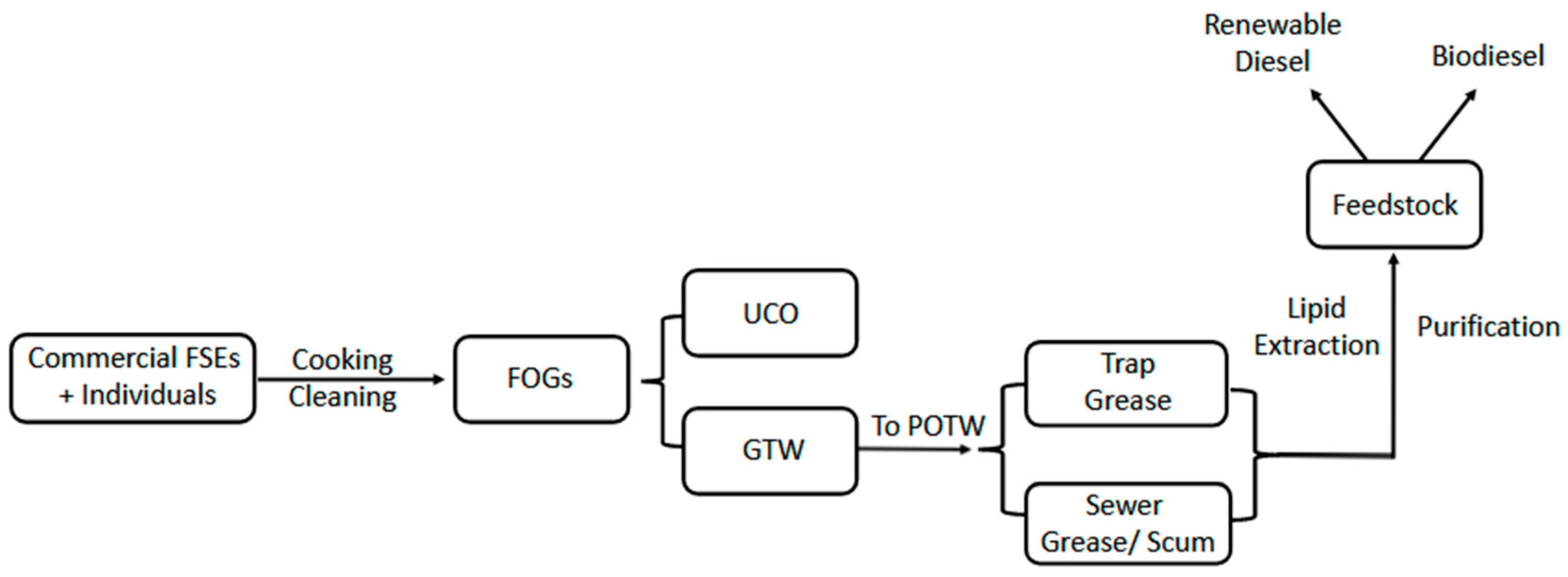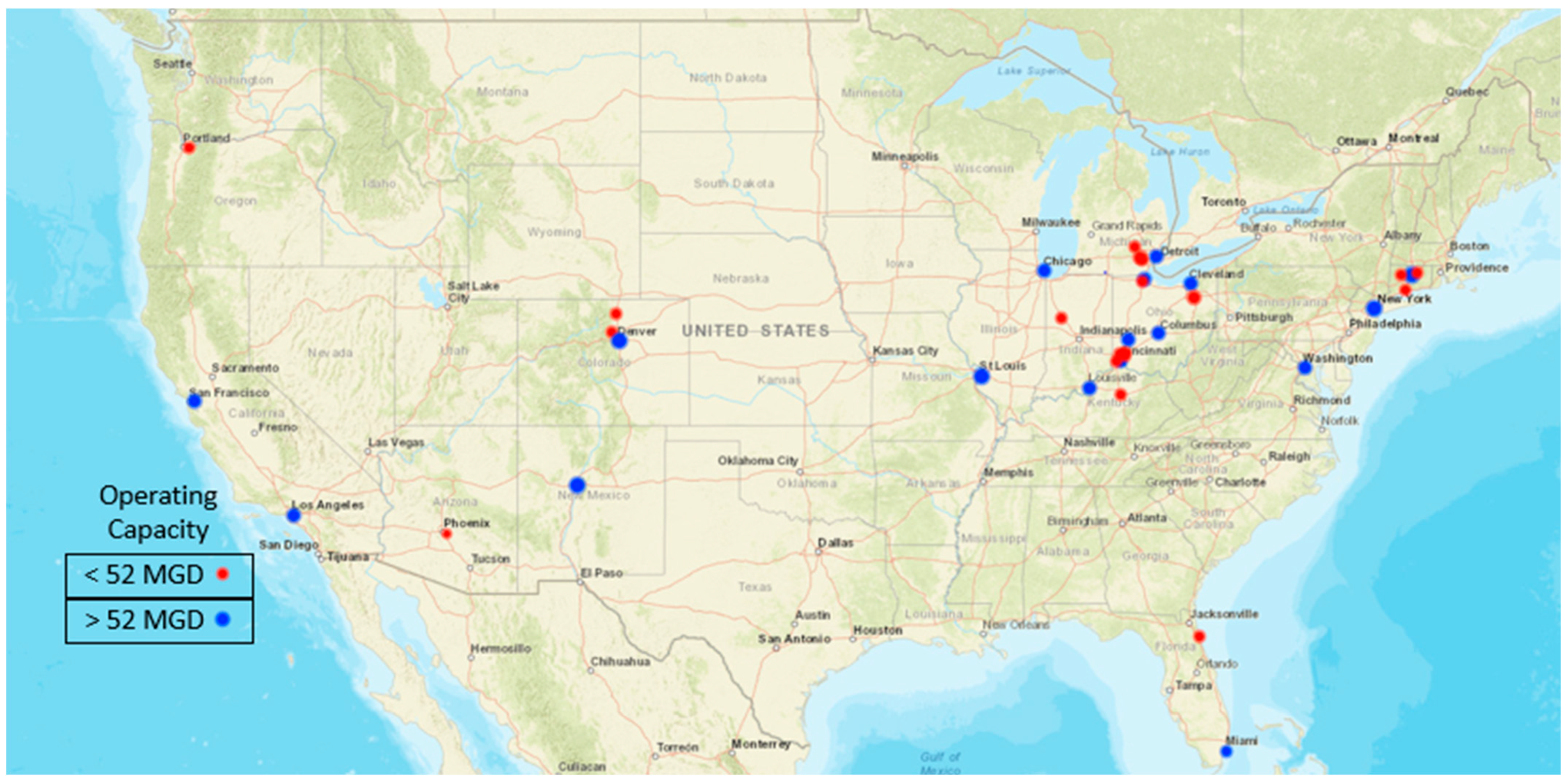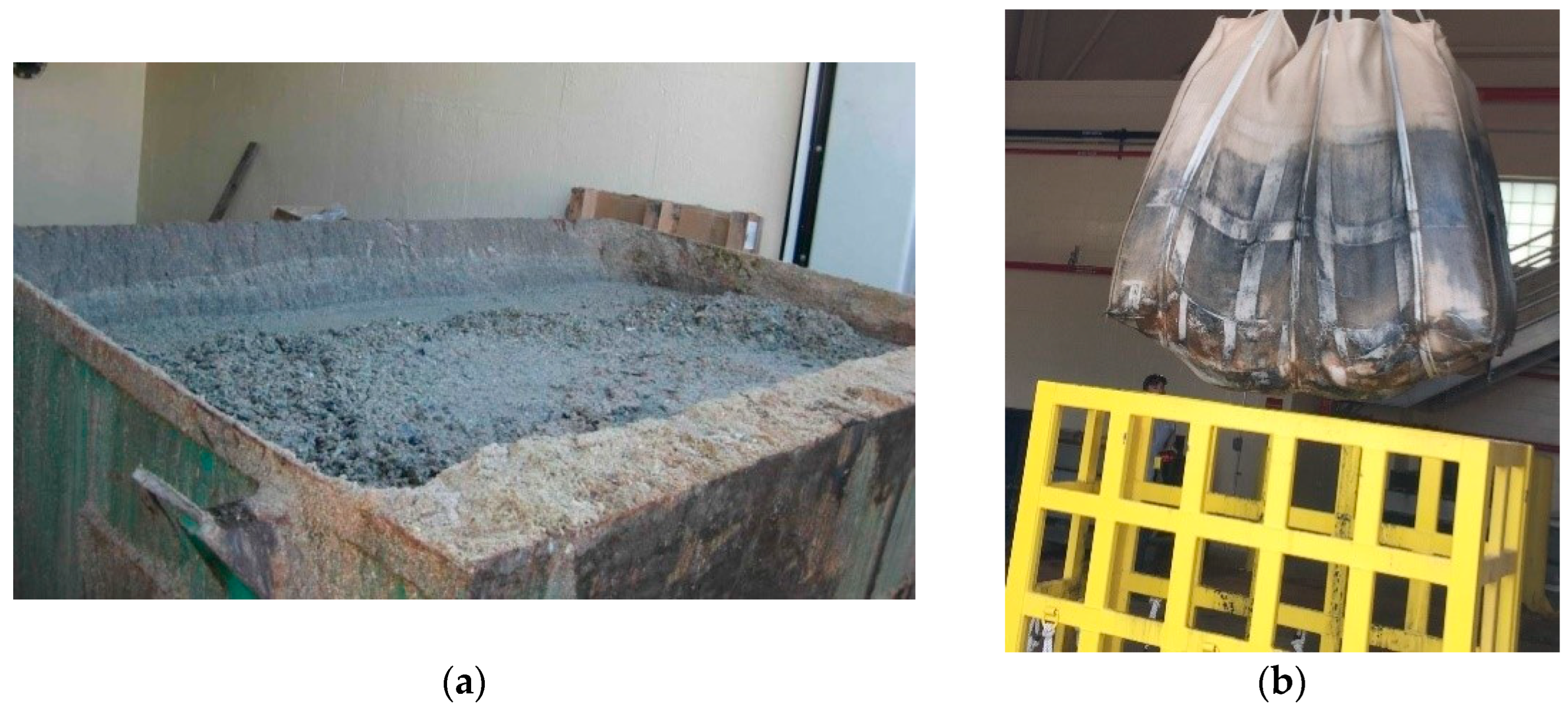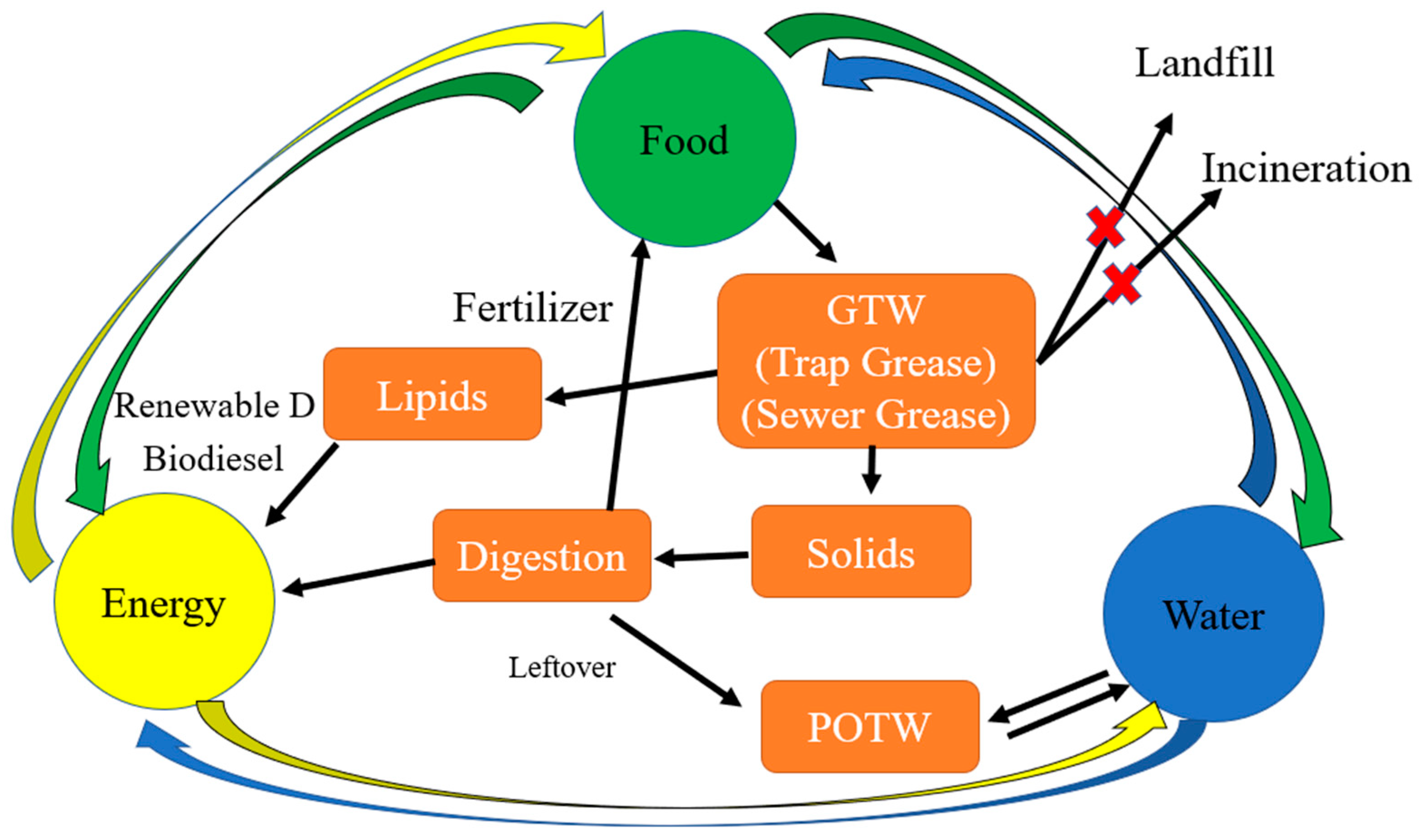A Review of Grease Trap Waste Management in the US and the Upcycle as Feedstocks for Alternative Diesel Fuels
Abstract
:1. Introduction
2. Current GTW Management in POTWs in the US
2.1. Landfill
2.2. Anaerobic Digestion
2.3. Incineration
2.4. Limitations
3. GTWs as Potential Feedstocks for ADFs
3.1. Potential Use as Feedstock for Biodiesel
3.2. Potential Use as Feedstock for Renewable Diesel
3.3. Repositioning GTW in the Food–Energy–Water Cycles
4. GTW Inventory and Properties as Alternative Diesel Fuels (ADFs)
4.1. A Brief Inventory of GTW and UCO in the US
4.2. GTW Properties Relevant to Upcycle as ADF Feedstocks
4.3. UCO/Yellow Grease Inventory
5. Conclusions
6. Future Directions
Supplementary Materials
Author Contributions
Funding
Data Availability Statement
Acknowledgments
Conflicts of Interest
References
- US EPA (Environmental Protection Agency). 40 CFR 403 National Pretreatment Program. 2012. Available online: https://www3.epa.gov/npdes/pubs/pretreatment_foodservice_fs.pdf (accessed on 10 June 2024).
- Gutierrez, S. Seattle’s Sewers Are Getting Clogged with Grease. Seattlep. 2011. Available online: http://www.seattlepi.com/local/article/Seattle-s-sewers-are-getting-clogged-with-grease-891503.php. (accessed on 26 May 2024).
- San Francisco Water, Power, and Sewer (SFWPS). Brown Grease to Biodiesel Demonstration Project. 2011. Available online: http://www.sfwater.org/modules/showdocument (accessed on 12 June 2024).
- University of North Carolina. In a FOG: Wastewater System Managers Struggle with Fat, Oil, and Grease. Water Resources Research Institute News. 2012, Number 335. Available online: https://repository.lib.ncsu.edu/server/api/core/bitstreams/ce4c0b26-0cfe-4220-af8a-2eaa0ff094fd/content (accessed on 14 June 2024).
- Moss, S. Don’t Feed the Fatberg! What a Slice of Oily Sewage Says about Modern Life. The Guardian: Waste. 2018. Available online: https://www.theguardian.com/environment/2018/feb/18/dont-feed-fatberg-museum-london-clogging-sewers-oil (accessed on 16 June 2024).
- Blanc, J.; Arthur, S. Management and Recovery of FOG (Fats, Oils, and Greases). Centre of Expertise for Waters. 2013. Available online: https://www.crew.ac.uk/sites/www.crew.ac.uk/files/sites/default/files/publication/CREW_FOG.pdf (accessed on 11 June 2024).
- Husain, I.A.F.; Alkhatib, M.F.; Jami, M.S.; Mirghani, M.E.S.; Bin Zainudin, Z.; Hoda, A. Problems, control, and treatment of fat, oil, and grease (FOG): A review. J. Oleo Sci. 2014, 63, 747–752. [Google Scholar] [CrossRef] [PubMed]
- Chan, H. Removal and recycling of pollutants from Hong Kong restaurant wastewaters. Bioresour. Technol. 2010, 101, 6859–6867. [Google Scholar] [CrossRef] [PubMed]
- Abomohra, A.; Elsayed, M.; Esakkimuthu, S.; El-Sheekh, M.; Hanelt, D. Potential of fat, oil and grease (FOG) for biodiesel production: A critical review on the recent progress and future perspectives. Prog. Energy Combust. Sci. 2020, 81, 100868. [Google Scholar] [CrossRef]
- National Restaurant Association. Fats Oils Greases. 2024. Available online: https://conserve.restaurant.org/Best-Practices/FOG (accessed on 11 June 2024).
- Seattle Municipal Code: 21.16.300. 2020. Available online: https://www.seattle.gov/utilities/protecting-our-environment/sustainability-tips/fats-oils-and-grease-(fog)/fog-commercial-kitchens#:~:text=Seattle%20Municipal%20Code%20prohibits%20the%20discharge%20of%20wastewater,from%20their%20private%20sewer%20line%20%28SMC%2021.16.300%20B%29 (accessed on 10 June 2024).
- Ferrise, A. Akron Officials Ask for Help Tracking Down Illegal Dumping of Grease into Sewer. Cleveland.com. 2015. Available online: https://www.cleveland.com/akron/2015/05/akron_officials_ask_for_help_t.html (accessed on 10 June 2024).
- Conn, J. Akron Asks for Public’s Help after Illegal, Mass Grease Dumping Clogs Pipes at Water Reclamation Plant. Cleveland.com. 2018. Available online: https://www.cleveland.com/akron/2018/03/akron_asks_residents_businesse.html (accessed on 16 June 2024).
- National Restaurant Association. National Restaurant Association Arms Members with Toolkit on Fats Oils and Grease FOG Control. Vending Times. 2017. Available online: https://www.vendingtimes.com/news/national-restaurant-association-arms-members-with-toolkit-on-fats-oils-and-grease-fog-control/ (accessed on 16 June 2024).
- Capital Regional District. Fats, Oils and Greases. 2024. Available online: https://www.crd.bc.ca/education/stormwater-wastewater-septic/at-home/protecting-plumbing-treatment/fats-oils-and-grease (accessed on 16 June 2024).
- Foden, M.; Browne, A.L.; Evans, D.M.; Sharp, L.; Watson, M. The water–energy–food nexus at home: New opportunities for policy interventions in household sustainability. Geogr. J. 2019 185, 406–418. [CrossRef]
- Tu, Q.; Wang, J.; Lu, M.; Brougham, A.; Lu, T. A solvent-free approach to extract the lipid fraction from sewer grease for biodiesel production. Waste Manag. 2016, 54, 126–130. [Google Scholar] [CrossRef] [PubMed]
- Machell, J.; Prior, K.; Allan, R.; Andresen, J.M. The water energy food nexus-challenges and emerging solutions. Environ. Sci. Water Res. Technol. 2015, 1, 15–16. [Google Scholar] [CrossRef]
- Wallace, T.; Gibbons, D.; O’Dwyer, M.; Curran, T.P. International evolution of fat, oil and grease (FOG) waste management—A review. J. Environ. Manag. 2017, 187, 424–435. [Google Scholar] [CrossRef] [PubMed]
- Haas, M.; Foglia, T. Alternate Feedstocks and Technologies for Biodiesel Production. In The Biodiesel Handbook, 2nd ed.; Gerhard Knothe, G., Krahl, J., Gerpen, J., Eds.; AOCS Publishing: Urbana, IL, USA, 2005; Available online: https://doi-org.uc.idm.oclc.org/10.1016/B978-1-893997-62-2.50001-2 (accessed on 12 June 2024).
- Gerveni, M.; Hubbs, T.; Irwin, S. Renewable Diesel Feedstock Trends over 2011–2022. Farmdoc Dly. 2023, 13, 231. Available online: https://farmdocdaily.illinois.edu/wp-content/uploads/2023/12/fdd122023.pdf (accessed on 12 June 2024).
- Xu, H.; Ou, L.; Li, Y.; Hawkins, T.; Wang, M. Life Cycle Greenhouse Gas Emissions of Biodiesel and Renewable Diesel Production in the United States. Environ. Sci. Technol. 2022, 56, 7512–7521. [Google Scholar] [CrossRef]
- Farrell, A.E.; Sperling, D.; Arons, S.M.; Brandt, A.R.; Delucchi, M.A.; Eggert, A.; Farrell, A.E.; Haya, B.K.; Hughes, J.; Jenkins, B.M.; et al. A Low-Carbon Fuel Standard for California Part 1: Technical Analysis. UC Berkeley: Transportation Sustainability Research Center, 2007. Available online: https://escholarship.org/uc/item/8zm8d3wj (accessed on 12 June 2024).
- California Air Resources Board. LCFS Data Dashboard. 2024. Available online: https://ww2.arb.ca.gov/resources/documents/lcfs-data-dashboard (accessed on 12 June 2024).
- US EPA. Clean Watersheds Needs Survey 2012 Report to Congress. 2016. Available online: https://www.epa.gov/cwns/clean-watersheds-needs-survey-cwns-2012-report-and-data (accessed on 16 June 2024).
- National Centers for Environmental Information. Geographical Reference Maps: U.S. Census Divisions. Climate Monitoring; 2024. Available online: https://www.ncei.noaa.gov/access/monitoring/reference-maps/us-census-divisions (accessed on 11 July 2024).
- McNeil, D. Resource Recovery Cooperatives for the Security of Consistent Quality Co-Digestion Feedstock. In Proceedings of the WEF Residuals and Biosolids Conference, Seattle, WA, USA, 8–11 April 2017; Available online: https://www.accesswater.org/publications/proceedings/-279717/resource-recovery-cooperatives-for-the-security-of-consistent--quality-codigestion-feedstock?pdfdownload=true (accessed on 12 June 2024).
- Scanlan, L. (Metropolitan Sewer District of Greater Cincinnati, Cincinnati, OH, USA). Personal communication, 2016.
- Crawford, J. (Sanitary District No. 1 in Northern Kentucky, Fort Wright, KY, USA). Personal communication, 2020.
- Las Angeles County Sanitation Districts. Tipping Fees for Solid Waste and Recyclables. 2024. Available online: https://www.lacsd.org/services/solid-waste/tipping-fees-for-solid-waste-and-recyclables#:~:text=%2DCalifornia%20Integrated%20Solid%20Waste%20Management,Management%20Fee%3A%20%241.50%20per%20ton. (accessed on 16 June 2024).
- Tu, Q.; Wang, J.; Lu, M.; Chai, M.; Lu, T. Feasibility and Practices of Making Biodiesel Out of Low-Quality Greases. EM Mag. 2012, 26–29. Available online: https://www.researchgate.net/publication/289723044_Feasibility_and_practices_of_making_biodiesel_out_of_low-quality_greases (accessed on 12 June 2024).
- Long, J.H.; Aziz, T.N.; Reyes, F.L.D.L.; Ducoste, J.J. Anaerobic co-digestion of fat, oil, and grease (FOG): A review of gas production and process limitations. Process Saf. Environ. Prot. 2012, 90, 231–245. [Google Scholar] [CrossRef]
- Gupta, R.; Meacham, D.L.; Parkins, P.; Peacock, T.A.; Montoya, A.L. Lifting the Fog from FOG Receiving. Proc. Water Environ. Fed. 2016, 2167–2185. [Google Scholar] [CrossRef]
- Cantrell, K.; Ro, K.; Mahajan, D.; Anjom, M.; Hunt, P.G. Role of thermochemical conversion in livestock waste-to-energy treatments: Obstacles and opportunities. Ind. Eng. Chem. Res. 2007, 8918–8927. [Google Scholar] [CrossRef]
- Ryckebosch, E.; Drouillon, M.; Vervaeren, H. Techniques for transformation of biogas to biomethane. Biomass Bioenergy 2011, 35, 1633–1645. [Google Scholar] [CrossRef]
- Seiple, T.E.; Coleman, A.M.; Skaggs, R.L. Municipal wastewater sludge as a sustainable bioresource in the United States. J. Environ. Manag. 2017, 197, 673–680. [Google Scholar] [CrossRef] [PubMed]
- Xu, D. (LA Sanitation District, Los Angeles, CA, USA). Personal communication, 2016.
- Watkins, D. (Torrington Water Pollution Control Facility, Torrington, CT, USA). Personal communication, 2022.
- Lu, M.; Tu, Q.; Jin, Y. The gutter oil issue in China. Proc. Inst. Civ. Eng. Waste Resour. Manag. 2013, 166, 142–149. [Google Scholar] [CrossRef]
- Aryanpur, V.; Rogan, F. Decarbonizing Road freight transport: The role of zero-emission trucks and intangible costs. Sci. Rep. 2024, 14, 2113. [Google Scholar] [CrossRef] [PubMed]
- Agnew, R.; Chai, M.; Lu, M.; Dendramis, N. Making biodiesel from recycled cooking oil generated in campus dining facilities. Sustain. J. Rec. 2009, 2, 303–307. [Google Scholar] [CrossRef]
- Chai, M.; Tu, Q.; Yang, J.; Lu, M. Esterification pretreatment of free fatty acid in biodiesel production, from laboratory to industry. Fuel Process. Technol. 2014, 125, 106–113. [Google Scholar] [CrossRef]
- Chakrabarti, A.R.; Hake, J.M.; Zarchi, I.; Gray, D.M.D. Waste Grease Biodiesel Production at a Wastewater Treatment Plant. Proc. Water Environ. Fed. 2008, 14, 2770–2789. [Google Scholar] [CrossRef]
- Wang, Z.M.; Lee, J.S.; Park, J.Y.; Wu, C.Z.; Yuan, Z.H. Optimization of biodiesel production from trap grease via acid catalysis. Korean J. Chem. Eng. 2008, 25, 670–674. [Google Scholar] [CrossRef]
- Jolis, D.; Loiacono, J.; Kwan, L.; Sierra, N.; Ving, K.; Martis, M. Co-location of brown grease to biodiesel production facility at the oceanside wastewater treatment plant in San Francisco, CA. Proc. Water Environ. Fed. 2010, 9, 6816–6829. [Google Scholar] [CrossRef]
- Ngo, H.L.; Xie, Z.G.; Kasprzyk, S.; Haas, M.; Lin, W.B. Catalytic synthesis of fatty acid methyl esters from extremely low quality greases. J. Am. Oil Chem. Soc. 2011, 88, 1417–1424. [Google Scholar] [CrossRef]
- Turner, N.B.; Landsburg, E.B.; Feldman, E.; Varghese, A.R.; Blaza, G. Beneficial reuses of sewer grease: Biodiesel production vs. anaerobic digestion. In Proceedings of the Air & Waste Management Association 104th Annual Conference, Orlando, FL, USA, 21–24 June 2011. Paper 2011-A-627-AWMA. [Google Scholar]
- Watson, E.G. Frying up Energy Independence—The Feasibility of Fats, Oils and Greases (FOG)-Derived Biofuel Production. Fla. Water Resour. J. 2011. Available online: http://www.fwrj.com/techarticles/0611%20tech1.pdf (accessed on 16 June 2024).
- Noshadi, I.; Kanjilal, B.; Du, S.; Bollas, G.M.; Suib, S.L.; Provatas, A.; Liu, F.; Parnas, R.S. Catalyzed production of biodiesel and bio-chemicals from brown grease using ionic liquid functionalized ordered mesoporous polymer. Appl. Energy 2014, 129, 112–122. [Google Scholar] [CrossRef]
- Yuttachana, N. Feasibility Study on Quantity and Fuel Properties of Extracted Lipid from Trap Grease Waste. Master’s Thesis, Mahidol University at Thailand, Nakhon Pathom, Thailand, 2006. [Google Scholar]
- Mondala, A.; Liang, K.; Toghiani, H.; Hernandez, R.; French, T. Biodiesel production by in situ transesterification of municipal primary and secondary sludges. Bioresour. Technol. 2009, 100, 1203–1210. [Google Scholar] [CrossRef] [PubMed]
- Pokoo-Aikins, G.; Heath, A.; Mentzer, R.A.; Mannan, M.S.; Rogers, W.J.; El-Halwagi, M.M. A multi-criteria approach to screening alternatives for converting sewage sludge to biodiesel. J. Loss Prev. Process. Ind. 2010, 23, 412–420. [Google Scholar] [CrossRef]
- Siddiquee, M.N.; Rohani, S. Lipid extraction and biodiesel production from municipal sewage sludges: A review. Renew. Sustain. Energy Rev. 2011, 15, 1067–1072. [Google Scholar] [CrossRef]
- Voegele, R. A Critical Component. Biodiesel Magazine. 2012. Available online: https://biodieselmagazine.com/articles/a-critical-component-8295, (accessed on 11 June 2024).
- Cairncross, R.A.; Olson, M.; Spatari, S. Extracting Lipids from Wastewater to Produce Biofuels. WE&RF Project Report. 2016. Available online: https://www.waterrf.org/research/projects/extraction-lipids-wastewater-produce-biofuels-0 (accessed on 16 June 2024).
- URS Corporation. Wastewater Sector State of the Industry Report: Conversion of Brown Grease to Biofuel; URS Corporation: San Francisco, CA, USA, 2010. [Google Scholar]
- Zhang, J. Utilization of Fats, Oils and Grease in Biodiesel Production: From Market Study to Technical Feasibility. Master’s Thesis, University of Cincinnati, Cincinnati, OH, USA, 2017. Available online: https://etd.ohiolink.edu/acprod/odb_etd/etd/r/1501/10?clear=10&p10_accession_num=ucin1511801164066707 (accessed on 16 June 2024).
- Mata, A.; Hughes, E.; Lu, M. Fats, Oils and Grease (FOGs) as a Potential Feedstock for Renewable Diesel. AWMA Mag. Environ. Manag. 2021, 35–37. Available online: https://www.awma.org/emmay21 (accessed on 16 June 2024).
- Leonard, J.; Couch, P. The Potential and Challenges of Renewable Diesel Fuel for Heavy-Duty Vehicles. Advanced Clean Tech News. 2017. Available online: https://www.act-news.com/news/the-potential-and-challenges-of-renewable-diesel-fuel-for-heavy-duty-vehicles/ (accessed on 16 June 2024).
- U.S. EIA. Table 10.4a: Biodiesel Overview. EIA Mon. Energy Rev. 2024, 1, 194. Available online: https://www.eia.gov/totalenergy/data/monthly/pdf/sec10_8.pdf (accessed on 10 June 2024).
- U.S. EIA. Table 10.4b: Renewable Deisel Fuel Overview. EIA Mon. Energy Rev. 2024, 1, 195. Available online: https://www.eia.gov/totalenergy/data/monthly/pdf/sec10_9.pdf (accessed on 10 June 2024).
- Knothe, G. Biodiesel and renewable diesel: A comparison. Prog. Energy Combust. Sci. 2010, 36, 364–373. [Google Scholar] [CrossRef]
- Smagala, T.G.; Christensen, E.; Christison, K.M.; Mohler, R.E.; Gjersing, E.; Mccormick, R.L. Hydrocarbon Renewable and Synthetic Diesel Fuel Blendstocks: Composition and Properties. Energy Fuels 2013, 27, 237–246. [Google Scholar] [CrossRef]
- Lu, M.; Tzillah, A.; Chai, M.; Aloraimi, O. Compositional Analysis of Biodiesel Particulate Matter (BPM) from a Non-Road Diesel Generator. Energies 2023, 16, 5010. [Google Scholar] [CrossRef]
- Arora, P.; Ojagh, H.; Woo, J.; Lind Grennfelt, E.; Olsson, L.; Creaser, D. Investigating the effect of Fe as a poison for catalytic HDO over sulfide NiMo alumina catalysts. Appl. Catal. B Env. 2018, 227, 240–251. [Google Scholar] [CrossRef]
- Tu, Q.; McDonnell, B.E. Monte Carlo analysis of life cycle energy consumption and greenhouse gas (GHG) emission for biodiesel production from trap grease. J. Clean. Prod. 2016, 112, 2674–2683. [Google Scholar] [CrossRef]
- Wiltsee, G. Urban Waste Grease Resource Assessment. National Renewable Energy Laboratory, 1998. Available online: https://www.nrel.gov/docs/fy99osti/26141.pdf (accessed on 12 June 2024).
- Wang, J. Feasibility Study for a Community scale Conversion of Trap Grease to Biodiesel. Master’s Thesis, University of Cincinnati, Cincinnati, OH, USA, 2012. Available online: https://etd.ohiolink.edu/acprod/odb_etd/ws/send_file/send?accession=ucin1330024170&disposition=attachment (accessed on 21 July 2024).
- Chesebrough, E.G. From GREASE traps to Bio-Gold? An Environmental and Economic Cost-Benefit Assessment of Converting Trap Grease to Biodiesel. Master’s Thesis, University of South Carolina at Columbia, Columbia, SC, USA, 2008. [Google Scholar]
- Collin, T.; Cunningham, R.; Deb, M.; Villa, R.; MacAdam, J.; Jefferson, B. Energy potential of household fats, oils and grease (FOG) waste. Water Environ. J. 2022, 36, 132–141. [Google Scholar] [CrossRef]
- Wan, C.; Zhou, Q.; Fu, G.; Li, Y. Semi-continuous anaerobic co-digestion of thickened waste activated sludge and fat, oil and grease. Waste Manag. 2011, 31, 1752–1758. [Google Scholar] [CrossRef] [PubMed]
- Kamperidou, V.; Terzopoulou, P. Anaerobic Digestion of Lignocellulosic Waste Materials. Sustainability 2021, 13, 12810. [Google Scholar] [CrossRef]
- Salama, E.-S.; Saha, S.; Kurade, M.B.; Dev, S.; Chang, S.W.; Jeon, B.-H. Recent trends in anaerobic co-digestion: Fat, oil, and grease (FOG) for enhanced biomethanation. Prog. Energy Combust. Sci. 2019, 70, 22–42. [Google Scholar] [CrossRef]
- He, X.; Iasmin, M.; Dean, L.O.; Lappi, S.E.; Ducoste, J.J.; de los Reyes, F.L., 3rd. Evidence for fat, oil, and grease (FOG) deposit formation mechanisms in sewer lines. Environ. Sci. Technol. 2011, 45, 4385–4391. [Google Scholar] [CrossRef]
- GlobalData. Global Supply and Trade of Used Cooking Oil. UCO Supply Outlook. 2023. Available online: https://cleanfuels.org/wp-content/uploads/GlobalData_UCO-Supply-Outlook_Sep2023.pdf (accessed on 16 June 2024).
- USDA. National Weekly Ag Energy Round-Up. Agricultural Marketing Service; 2024. Available online: https://www.ams.usda.gov/mnreports/lswagenergy.pdf (accessed on 16 June 2024).
- Chai, M. (American Green Fuels, New Haven, CT, USA). Personal communication, 2024.
- Osman, A.; Fang, B.; Zhang, Y.; Liu, Y.; Yu, J.; Farghali, M.; Rashwan, A.; Chen, Z.; Ihara, I.; Rooney, D.; et al. Life cycle assessment and techno-economic analysis of sustainable bioenergy production: A review. Environ. Chem. Lett. 2024, 22, 1115–1154. [Google Scholar] [CrossRef]





| Time Period | Moisture, wt% | Lipid Content, wt% | Solids, wt% | |
|---|---|---|---|---|
| Sewer Grease | Prior to 2016 | 58.9 | 22.9 | 18.2 |
| Summer 2016 | 37.81 | 30.50 | 31.69 | |
| Winter 2017 | 39.62 | 29.8 | 30.58 | |
| Fall 2019 | 39.60 | 30.85 | 29.55 | |
| Winter 2020 | 33.51 | 32.22 | 34.27 | |
| Trap Grease | Winter 2017 | 53.81 | 23.35 | 22.34 |
| Fall 2019 | 51.04 | 32.00 | 18.69 | |
| Winter 2020 | 42.66 | 49.01 | 8.33 |
| wt% | C | H | O | N | C/N Ratio | |
|---|---|---|---|---|---|---|
| Sewer Grease—Summer 2016 | SG | 69.32 | 10.95 | 19.35 | 3.28 | 24.66 |
| Solids | 69.25 | 10.02 | 18.64 | 3.02 | 26.75 | |
| Sewer Grease—Winter 2017 | SG | 67.83 | 9.74 | 19.63 | 2.65 | 29.86 |
| Solids | 68.19 | 10.38 | 20.88 | 2.41 | 33.01 | |
| Trap Grease—Winter 2017 | TG | 69.17 | 10.12 | 17.23 | 3.15 | 25.62 |
| Solids | 70.36 | 10.53 | 16.32 | 2.79 | 29.42 |
| Na | Ca | Mg | Fe | Cu | |
|---|---|---|---|---|---|
| Sewer Grease | 371.15 | 6867.28 | 141.50 | 513.35 | 124.02 |
| Trap Grease | 408.91 | 1420.33 | 254.96 | 531.78 | 15.95 |
Disclaimer/Publisher’s Note: The statements, opinions and data contained in all publications are solely those of the individual author(s) and contributor(s) and not of MDPI and/or the editor(s). MDPI and/or the editor(s) disclaim responsibility for any injury to people or property resulting from any ideas, methods, instructions or products referred to in the content. |
© 2024 by the authors. Licensee MDPI, Basel, Switzerland. This article is an open access article distributed under the terms and conditions of the Creative Commons Attribution (CC BY) license (https://creativecommons.org/licenses/by/4.0/).
Share and Cite
Mata, A.; Zhang, J.; Pridemore, J.; Johnson, K.; Holliday, N.; Helmstetter, A.; Lu, M. A Review of Grease Trap Waste Management in the US and the Upcycle as Feedstocks for Alternative Diesel Fuels. Environments 2024, 11, 159. https://doi.org/10.3390/environments11080159
Mata A, Zhang J, Pridemore J, Johnson K, Holliday N, Helmstetter A, Lu M. A Review of Grease Trap Waste Management in the US and the Upcycle as Feedstocks for Alternative Diesel Fuels. Environments. 2024; 11(8):159. https://doi.org/10.3390/environments11080159
Chicago/Turabian StyleMata, Andres, Junsong Zhang, Joshua Pridemore, Kevin Johnson, Nathan Holliday, Art Helmstetter, and Mingming Lu. 2024. "A Review of Grease Trap Waste Management in the US and the Upcycle as Feedstocks for Alternative Diesel Fuels" Environments 11, no. 8: 159. https://doi.org/10.3390/environments11080159






